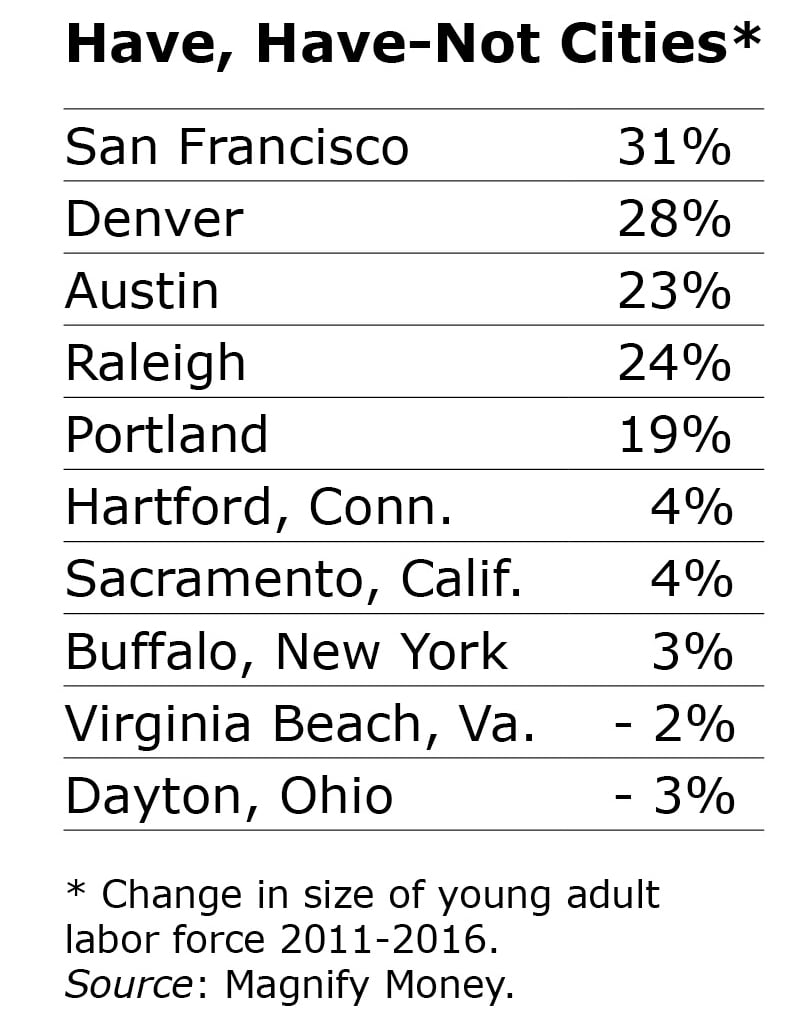
Millennial Cities and Those Left Behind
Sumat Lam, a recent college graduate, was skeptical when his Silicon Valley employer transferred him to Austin, Texas. What he found was a high-tech mecca that defies the stereotypes of 10-gallon hats and Southern drawls.
Google, Apple and Amazon have established outposts in the “Silicon Hills” of Texas’ Hill Country. The young workers moving there are “bringing in their culture and influences from Boston and New York,” Lam told VOA News.
Taylor Hardy lives in Dayton, Ohio, but she might as well be living on a different planet.
This young nursing assistant can barely eke out a living. Her plight is shared by too many others in this former industrial hub that has been in a downward spiral that accelerated after plant closings by National Cash Register and General Motors during the last recession. The loss of high-quality blue-collar jobs contributes to Dayton’s 35 percent poverty rate – nearly three times the national rate.
Hardy, a single mother, and the boyfriend who lives with her, earn a total of $27,000 a year – she has $5 in her bank account. “I work all these hours, and I miss all the time with my kids to make … nothing,” she said in the PBS Frontline documentary “Left Behind America.”
The contrasting fortunes in these two cities – Austin versus Dayton – are playing out around the country. Young professionals are streaming into Millennial boomtowns from San Francisco to Boston, where growth seems almost unstoppable. But outside these hot spots are struggling Midwestern and Northeastern cities that have become deserts, devoid of opportunity for their young adult residents.
 “Historically, many young American adults have left their hometowns to chase better opportunities,” said Kali McFadden, senior analyst at Magnify Money. “But not all millennials have the same work opportunities,” she said about her firm’s new city ranking of the employment available to young workers.
“Historically, many young American adults have left their hometowns to chase better opportunities,” said Kali McFadden, senior analyst at Magnify Money. “But not all millennials have the same work opportunities,” she said about her firm’s new city ranking of the employment available to young workers.
A college education is increasingly the dividing line for those who are able to relocate for a better job and those who remain behind.
At the top of Magnify Money’s ranking of boomtowns, based on U.S. Census data between 2011 and 2016, are obvious places like Austin, Denver, and Portland. The firm’s analysis finds that the young adult labor force in these and other millennial boomtowns, including Nashville and Raleigh, is growing much faster than this population overall. “Clearly, they are hungry for younger employees,” McFadden said.
The typical young worker’s income increased at least 25 percent in five years in Nashville, Portland, San Francisco, and San Jose in Silicon Valley, vaulting them into the top tier of desirable cities for people seeking good jobs and opportunities.
Many other cities are languishing. While the U.S. unemployment rate is a rock-bottom 3.7 percent, Philadelphia’s unemployment rate for that age group is 8.8 percent. The young adult labor force is shrinking or barely growing in Dayton, Virginia Beach, Buffalo, Hartford, and Sacramento. Wage growth has been very sluggish or negative over the past five years in Richmond and Virginia Beach.
A Financial Times reporter who was interviewed in “Left Behind” explains the broad economic changes behind the startling contrast between have and have-not cities for Millennials.
Wealth, she said, “lives in financial assets on Wall Street or in intellectual property in Silicon Valley.” In Dayton, “there’s nobody earning money. There’s nobody to buy stuff, and these economies collapse.”
When they do, their young adults’ hopes often collapse with them.
Squared Away writer Kim Blanton invites you to follow us on Twitter @SquaredAwayBC. To stay current on our blog, please join our free email list. You’ll receive just one email each week – with links to the two new posts for that week – when you sign up here.
Comments are closed.







Interesting how just a few miles makes a difference. Dayton is just 8 miles west of me, & median household income there is $28K/yr; here it’s $83K/yr, & in Oakwood, just a few miles south of both our cities, it’s probably about $110K+.
We have many high-quality white-collar jobs in this region, as well as many blue-collar jobs being generated – in every instance, salary all depends on the specific degree/certification & skillsets. Many college graduates with engineering bachelor degrees starting at between $55K-$70K/yr.
Opportunities are readily available. There are many similar success stories here.
The focus on the plight of a nursing assistant in Dayton may be misplaced. It isn’t clear that she would be that much better off in Austin. The income advantage associated with certain metropolitan areas is rather enterprise-specific.
I worked in Philadelphia, PA (mentioned above) for many years and can state much of the city is now experiencing a real estate boom fueled by the growth of jobs in the “Eds & Meds” sectors. We have many great universities and hospitals hiring, but that is little help for poorer minority residents lacking higher education who keep Philadelphia as America’s largest poor city.
It is so much more than just a question of geography.